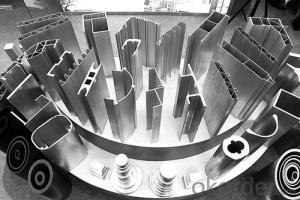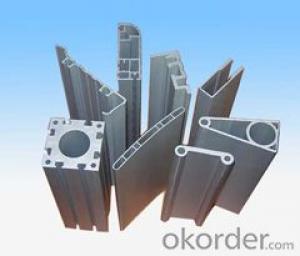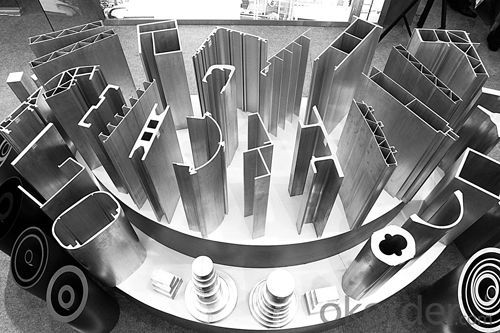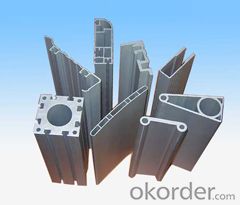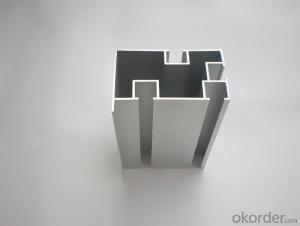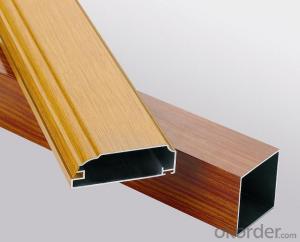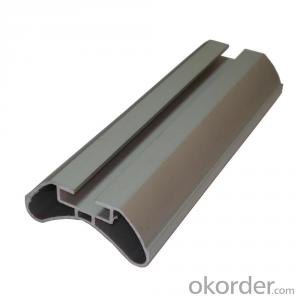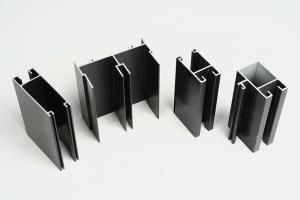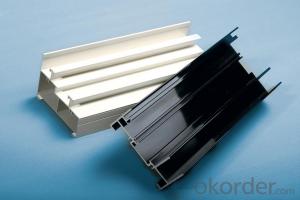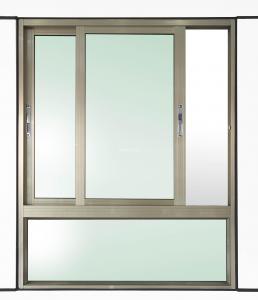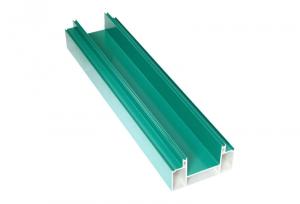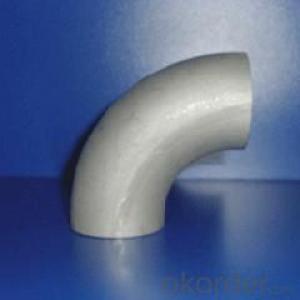Aluminum Profiles for Windows Xingyu - Alu Extrusion Profiles 6061
- Loading Port:
- Guangzhou
- Payment Terms:
- TT OR LC
- Min Order Qty:
- 10 m.t.
- Supply Capability:
- 100000 m.t./month
OKorder Service Pledge
OKorder Financial Service
You Might Also Like
Specification
Aluminium is a relatively soft,durable, lightweight, ductile and malleablemetal with appearance ranging from silvery to dull gray,depending on the surface roughness. It is nonmagnetic and does not easilyignite. A fresh film of aluminium serves as a good reflector (approximately92%) of visible light and an excellent reflector (as much as98%) of medium and far infrared radiation. The yield strength of pure aluminium is 7–11 MPa,while aluminium alloys have yield strengths ranging from200 MPa to 600 MPa. Aluminium has about one-third the density and stiffnessof steel. It iseasily machined,cast, drawn and extruded.
Alu Profile:
Material | Alloy 6063,6061,6005or according to customer’s choice |
Temper | T3, T4, T5, T6 |
Surface | Anodize, electrophoresis, powder coating, PVDF coating, wood grain painting, matted, etc. |
Length | Coating 6.5 meters, Anodizing 6.5 meters, Mill finish 5 meters |
Application | Industrial, electrical equipment(TV set, air conditioner, refrigerator, computer), decoration,construction, transportation |
Custom Made | We can package following with customer's request. |

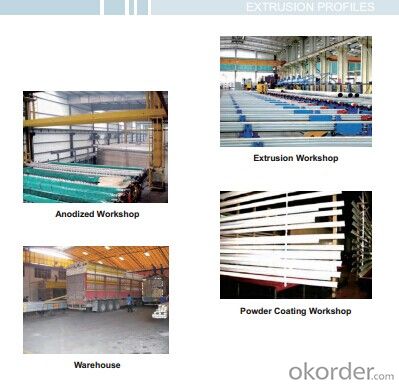
Our Advantages
1. Excellent quality of products
2. Quick delivery
3. Best service to clients
4. BV,SGS avalible
5. No buckle o waveness
6. Tension leveling
7. Certificate of Origin
8. FormeA,E
- Q: Aluminum profile connecting piece
- Very little to buy this alone, and only with industrial aluminum suppliers. - selling on Taobao is also a way if the price is appropriate.
- Q: How do aluminum profiles compare to plastic profiles?
- Aluminum profiles generally offer greater strength, durability, and stability compared to plastic profiles. They can withstand higher loads and have higher resistance to heat, chemicals, and UV radiation. Additionally, aluminum profiles provide more design flexibility, as they can be easily machined, welded, and anodized to achieve desired shapes and finishes. However, plastic profiles are often more cost-effective and lighter in weight, making them suitable for certain applications where strength and rigidity are not critical. Ultimately, the choice between aluminum and plastic profiles depends on the specific requirements and constraints of the project.
- Q: Are aluminum profiles suitable for use in exterior wall insulation systems for residential buildings?
- <p>Yes, aluminum profiles can be used for exterior wall insulation systems in residential buildings. They are known for their durability, corrosion resistance, and low thermal conductivity, which makes them ideal for creating thermal barriers. Aluminum profiles can support the structure of the insulation system, providing a stable framework while also contributing to energy efficiency by reducing heat transfer. However, it's important to ensure that the profiles are properly sealed and insulated to prevent thermal bridging and to maintain the overall insulation performance of the building envelope.</p>
- Q: Are aluminum profiles suitable for use in the mining industry?
- The mining industry can benefit greatly from the use of aluminum profiles. Aluminum, known for its lightweight yet strong and durable qualities, offers numerous advantages in mining applications. One crucial advantage of aluminum profiles lies in their exceptional resistance to corrosion. In the mining industry, where equipment often faces harsh environmental conditions and exposure to chemicals, this corrosion resistance is vital. Aluminum profiles can endure moisture, chemicals, and other corrosive substances without deteriorating, ensuring long-lasting performance and minimizing maintenance costs. Another perk of aluminum profiles is their impressive strength-to-weight ratio. Compared to other metals commonly used in mining equipment, such as steel, aluminum is significantly lighter. This lightweight characteristic makes aluminum profiles easier to handle, transport, and install, resulting in saved time and reduced labor costs. Despite being lightweight, aluminum profiles are still robust enough to withstand the demanding conditions of the mining industry, making them a reliable choice for various applications. Furthermore, aluminum profiles offer excellent thermal conductivity. This property proves advantageous in mining operations involving heat-generating machinery or processes. Aluminum profiles efficiently dissipate heat, preventing equipment overheating and enhancing overall safety and productivity. Moreover, aluminum is a non-magnetic material, making it ideal for mining operations that require non-magnetic equipment. This characteristic ensures that aluminum profiles will not interfere with sensitive equipment or disrupt magnetic fields, maintaining the accuracy and reliability of mining processes. In summary, aluminum profiles are highly suitable for the mining industry due to their corrosion resistance, high strength-to-weight ratio, thermal conductivity, and non-magnetic properties. Integrating aluminum profiles into mining equipment can improve performance, reduce maintenance costs, and enhance overall efficiency in various mining applications.
- Q: Are aluminum profiles suitable for use in roofing or wall systems?
- <p>Yes, aluminum profiles are commonly used for both roofing and wall systems due to their durability, corrosion resistance, and lightweight properties. They offer a modern aesthetic and can be easily integrated into various architectural designs. Aluminum profiles are also known for their strength and flexibility, allowing for the creation of complex shapes and structures. Additionally, they require minimal maintenance and can withstand harsh weather conditions, making them a popular choice for construction projects.</p>
- Q: Are aluminum profiles suitable for use in the telecommunications industry?
- Yes, aluminum profiles are suitable for use in the telecommunications industry. Aluminum is a lightweight and durable material that offers several advantages in this industry. Firstly, aluminum profiles are corrosion-resistant, making them ideal for outdoor installations such as telecommunication towers and antennas that are exposed to harsh weather conditions. This corrosion resistance ensures the longevity and reliability of the equipment. Secondly, aluminum profiles have excellent thermal conductivity properties, allowing them to dissipate heat efficiently. This is particularly important in the telecommunications industry, where heat generated by electronic components can be detrimental to their performance. By using aluminum profiles, cooling systems can be optimized, ensuring the proper functioning of the equipment. Moreover, aluminum profiles are highly versatile and can be easily customized and fabricated to meet specific requirements. This enables telecommunications companies to design and construct structures, enclosures, and mounting solutions that are tailored to their needs. Aluminum profiles can be easily assembled, disassembled, or modified as necessary, offering flexibility in installation and maintenance. Additionally, aluminum profiles provide electromagnetic shielding properties, which is crucial in minimizing interference between different communication systems. This shielding helps maintain the quality and reliability of the transmitted signals. Furthermore, aluminum is a sustainable material, as it is 100% recyclable and has a low carbon footprint compared to other metals. This makes it an environmentally friendly choice for the telecommunications industry, aligning with the increasing focus on sustainability and reducing environmental impact. In conclusion, aluminum profiles are highly suitable for use in the telecommunications industry due to their corrosion resistance, thermal conductivity, versatility, electromagnetic shielding properties, and sustainability. These qualities make aluminum profiles a reliable and efficient choice for various applications in telecommunications infrastructure.
- Q: This question asks about the various techniques used to install aluminum profiles in construction projects.
- <p>There are several methods for installing aluminum profiles in construction: 1. Direct Fixing: Using screws or bolts directly into the aluminum profile. 2. Mortise and Tenon Joints: Joining profiles with a slot and a protruding part that fits into it. 3. Welding: Joining aluminum profiles using heat to melt and fuse them together. 4. Adhesive Bonding: Using adhesives to bond aluminum profiles together. 5. Mechanical Fasteners: Using nuts, bolts, and other fasteners to join profiles. 6. Clipping: Attaching profiles using clips or clamps. 7. Slot and Pin: A system where a pin fits into a slot in the profile. Each method has its advantages and is chosen based on the specific requirements of the construction project, such as load-bearing needs, aesthetic considerations, and ease of installation.</p>
- Q: Can aluminum profiles be used in the production of electronics?
- Indeed, the utilization of aluminum profiles is viable when it comes to manufacturing electronics. Aluminum, being a metal that is both lightweight and resistant to corrosion, possesses exceptional thermal conductivity properties, rendering it suitable for a multitude of electronic applications. It is frequently employed in the fabrication of electronic enclosures and heat sinks. The malleability of aluminum profiles facilitates their effortless transformation into various shapes and sizes, thus enabling customization and flexibility in the creation of electronic components. Moreover, due to their electrical conductivity, aluminum profiles often serve the purpose of electromagnetic shielding. In summary, the incorporation of aluminum profiles in the production of electronics offers a plethora of benefits, including durability, efficient thermal management, and versatile design capabilities.
- Q: Is it feasible to recycle aluminum profiles and what factors affect the recycling process?
- <p>Yes, aluminum profiles can be recycled easily. Aluminum is one of the most recycled materials globally due to its low melting point, which requires less energy for recycling compared to other metals. The recycling process involves melting the aluminum, which can be done at temperatures significantly lower than those needed for other metals. Additionally, aluminum retains its properties even after multiple recycling cycles, making it an ideal material for sustainable use. The recycling rate of aluminum is high, and it contributes to energy savings and reduced environmental impact. However, the ease of recycling can be affected by factors such as the presence of impurities, the complexity of the profile shapes, and the efficiency of collection systems.</p>
Send your message to us
Aluminum Profiles for Windows Xingyu - Alu Extrusion Profiles 6061
- Loading Port:
- Guangzhou
- Payment Terms:
- TT OR LC
- Min Order Qty:
- 10 m.t.
- Supply Capability:
- 100000 m.t./month
OKorder Service Pledge
OKorder Financial Service
Similar products
Hot products
Hot Searches
Related keywords
